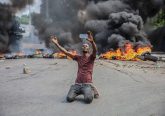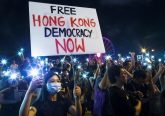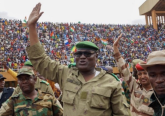I recently travelled to Yemen’s remote and dangerous Mahra region to carry out the first ever survey of the local people’s hopes, fears and political aspirations in post-revolution Yemen. Here is a description of some of my experiences.
“Yallah, pack up. We leave in ten minutes.” For security reasons, our schedule was not revealed in advance, even to me.
Our convoy had settled for a few days in al-Ghayda, the ramshackle capital of Mahra governorate in east Yemen, and word of our presence was spreading fast. Invitations from local dignitaries had increased from a trickle to a flood. Traditional hospitality was the best way for opponents with vested interests to learn what we were up to.
It was time to move on. My tribal guards and hosts were eager for me to experience the beauty and hospitality of the deserts. Few outsiders, even Yemeni, have been given the chance to venture away from Mahra’s coastal regions into the uncharted interior.
Making a stop at a final gas station before heading north off-road into the undulating sands of the Empty Quarter, we loaded our convoy with as much water and petrol as we could carry.
Dotted around the station were well-armed men in trucks. Look-outs. My guards recognized them from the compound where a powerful tribe had invited us to share trays of lamb the previous day. Outside the compound, the rules of hospitality no longer applied. Yesterday’s hosts became today’s hostiles.
As we continued on our way, my guards were on edge and every 40 minutes or so, the convoy would pull over and swap me swiftly into a different vehicle. Just a precaution, they assured me.
Suddenly, an almighty crunching sound shattered the desert peace and we realized the exhaust had dropped off. “Why aren’t we pulling over?” I shouted. The men assured me with unconvincing smiles, “Not here”. I grasped from their chat that we were passing through territory where quantities of guns lay hidden among the dunes, waiting for their onward journey to rebels in Yemen’s far north.
When we finally arrived at the flickering fires of our intended desert encampment, we feasted on roast camel late into the night. The next morning, the tribesmen were keen to show me around. “Yallah, Doctoora Aisha” they shouted as I stumbled after them over sandy rocks under a flaming sun. I wished I could shed my suffocating black abaya with its matching polyester headscarf and veil, all now caked in sand.
My guards had taken to calling me Doctoora Aisha, demonstrating both the intense respect for academic credentials and a good-humoured distaste for Elisabeth, which they considered both unwieldy and un-Islamic.
They encouraged me up the slope to view the strange white markers that had been the subject of much speculation during our long desert journey. “Tell us, what do they mean?”
Over several days now, I had been inundated with questions. How deep are the (geological) sinkholes in the desert? Why do bubbles appear on the surface of water in our clay reservoirs? Are these abandoned heaps of rocks and bones part of an ancient civilization? Mahris have an insatiable curiosity and thirst for knowledge. In this vast swathe of Yemen where only 3 percent of the population had ever accessed the internet, I was sorry to disappoint (no chance of sneaking a peek at Wikipedia here).
I eyed the large white marker, one of five we counted over roughly 50 kilometres of blistering desert. Some of the tribesmen believed they might be symbols of a rival religion and had tried to destroy them with hammers, then guns. Roughly annually, they told me, a small team arrived unannounced to maintain them super-quick, always disappearing again before locals could gather. I wondered, could there be oil under their deserts? Were outsiders marking a potential field and biding their time?
We bumped along, the air filled with desert songs and poetry that captured the rhythm of the convoy. The tribesmen wanted to show me their rocket launchers and sub-machine guns in action and the mood was boisterous and good-humoured. We passed an old military landing strip in the sand that now serves as a racetrack for an annual camel jamboree.
Suddenly, an eerie graveyard of burnt out trucks and equipment loomed before us – clearly a site of previous target practice. It turned out that oil companies had tried exploration in Mahra briefly in the 1940s and 1960s. Did then my suspicions about the shiny new markers have real substance? They had been put off by tribal hostility, discouraging results and – in the 1960s – escalating regional violence as the Marxist-leaning National Liberation Front tried to extend its control over southern Arabian sheikhdoms and sultanates, culminating in the establishment of South Yemen in 1967.
Later, I tried with the tribesmen to piece together where we had been on a crude official map. Other than borders and the odd dry river bed, the deserts remain virtually uncharted. It came as a shock to note that areas they considered to be part of Mahra were actually now marked as territory belonging to the neighbouring governorate of Hadramawt.
All the locals I had met considered themselves Mahri. They spoke Mahri, they even retained Mahri flags from the 1960s. Older maps of the former Sultanate of Mahra and Socotra depicted its lands stretching many kilometres further north-west, prior to its forcible abolition in 1967 and, with it, the execution of several tribal leaders. On whose authority was this new border for Mahra formalised and why were the inhabitants not consulted?
I suspected that the oil and water rumoured to lie beneath these deserts might have something to do with it. Given the distinct Mahri culture, identity and language, developed over many centuries of autonomy, not to mention widespread disenchantment with Yemeni rule (ever more corrupt since the union of Yemen’s south and north in 1990), Mahra’s territorial integrity remains important.
Small wonder that this impoverished people feel disenfranchised by Yemen’s national dialogue, a gathering of political leaders to draft a new constitution and address the conflicts that threaten to tear the country apart. It’s in full swing over a thousand kilometres away in the capital Sana’a.
Yet Mahra wants to be heard. Hence the tribes’ enthusiastic collaboration with our survey of people’s hopes and political aspirations. For the first time, Mahris will have a comprehensive and reliable picture of what they themselves want for their lands and their future.
This is the second in a series of blogs written for Thomson Reuters Foundation recounting my journey. This post originally appeared on their website.







No Comment